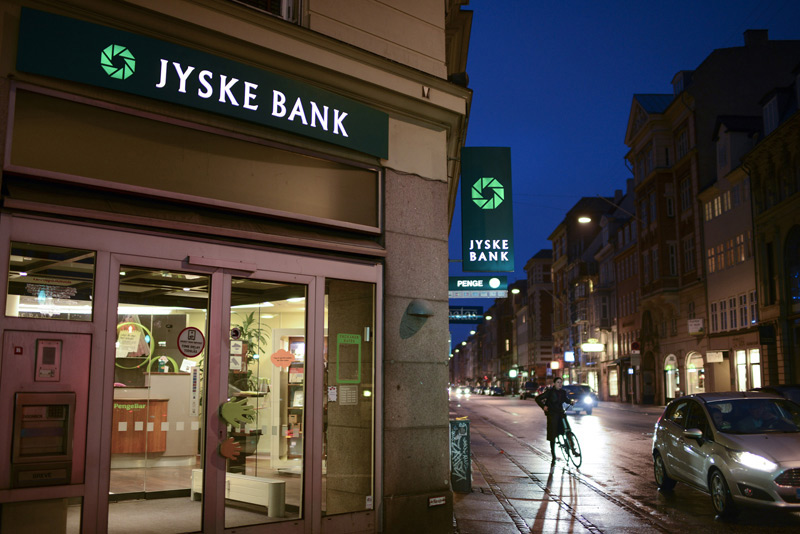发房贷不但不收利息,还倒贴钱,这家银行疯了吗?

|
这听起来像是个笑话:一家银行提供负利率房贷,希望通过数量来弥补损失。 但这是现实,至少对于丹麦第三大银行日德兰银行(Jyske Bank)来说是这样。该机构提供10年期-0.5%的固定利率按揭贷款。如果你买了房,能因此挣到钱。 但是,先别急,不用现在就打开学习丹麦语的节目,掸去护照上的灰尘。尽管这听起来很疯狂,但其背后的细节却令人大开眼界,充分说明了全球经济可能的走向。 负利率房贷的概念听上去就不可能成功。“我从没有见过也没有听说过负利率贷款,也不认为美国金融机构会实施负利率。”Alliant Credit Union负责住宅贷款业务的副总裁杰瑞·安德森表示,“这种做法非常极端,很可能仅限于丹麦。” 确实如此,至少就目前而言。 丹麦是欧盟成员国,但不使用欧元,而是保留了自己的货币克朗(krone,复数为kroner),就像英国保留了英镑一样。 “我们对欧元有固定汇率。”日德兰银行的按揭贷款专家米克尔·霍伊表示。丹麦必须“遵循(欧洲央行)的政策”。换句话说,当欧洲央行改变利率时,丹麦必须同时改变利率,以保持货币的汇率不变。 欧洲央行目前的存款利率为-0.4%。因此,丹麦的基准利率目前为-0.65%,给养老基金等需要存钱的投资机构带来了战略性难题。只要把钱放在任何一种形式的储蓄里,钱都会缩水。如果把所有资金都投在股票和其他投资工具里,一旦市场下跌,你可能会缺乏足够现金来支付必要的款项。 虽然负利率房货看起来会让银行无法盈利,但事实并不一定如此。这是因为丹麦拥有独特的按揭贷款支持债券,机构投资者又有分散风险的需求。 根据霍伊的说法,这个国家有200年抵押债券的历史。他们的抵押债券与导致次贷危机的主要因素“担保债务凭证”(CDO)完全不同。CDO将数千种次级抵押贷款组合在一起,借此推动发行债券,再将这些债券打包在一起,获得主要信用评级机构的高评级。 然而,这类按揭贷款往往包括通过不正当手段获取的贷款。结果是,高评级债券的基础是大量不稳定的贷款,这些贷款最终一定会崩盘。 在丹麦,债券是和投资相匹配的。每笔按揭抵押贷款都有一个单一的投资人——通常是像养老基金这样的机构,他们会在做出同意交易的决定前获得特定借款人的全部财务信息。 当前情况下,丹麦购房者通过银行向投资者借款,但不会获得全额贷款。获得10万美元抵押贷款的人只能够获得9.5万美元现金,但仍然需要偿还10万美元。投资者拥有这5000美元的差额,并在10年的还款期限内得到10万美元。 请耐心听我们解释。除了支付10万美元,购房者还需向银行支付0.3%的利息以及一些初始费用,这就是银行盈利的方式。但在抵押贷款期间,投资者需要向购房者支付贷款金额的0.5%,也就是说他们要赔钱。但有了投资者提供的0.5%,购房者贷款时能够净得0.2%的利息利润。银行得到0.3%的利息加上一些费用。唯一没有盈利的是投资者,他们借出的钱损失了0.5%。 为什么机构要投资于那些收益必然为负的东西呢?因为他们担心投资在其他领域里可能会损失更多的钱。 比如说,丹麦的机构可以投资美国国债,而不投资按揭贷款。8月1日至9日期间,美国国债每日的价格均有所下降。六个月期间,从2.04美元跌到了1.95美元。10年期国债从1.9美元跌至1.74美元。与此同时,丹麦和美国之间的汇率波动一直很大。从7月中旬到8月中旬,汇率下跌了4%。随着美元走强,购买同样的债券需要更多的克朗。 霍伊称,丹麦的机构担心美元的强势不会持久。在下跌过程中,以本币计价的债券价值会下跌,最终可能出现的损失会超过支持按揭贷款所需要的0.5%的成本。 这是在经济波动时期分散潜在风险的一种尝试。尽管目前这种情况只发生在丹麦,但这是一个时代的标志,而且不是一个非常好的标志。(财富中文网) 译者:Agatha |
It sounds like the wind up for a joke: a bank offers negative interest rates mortgages and hopes to make up the losses with volume. But it’s a reality, at least for Jyske Bank, the third largest market share bank in Denmark. The institution is offering ten-year -0.5% fixed-interest mortgages. You buy the house and get paid as a result. But don’t get a Danish language learning program and dust off that passport just yet. As crazy as it sounds, the details behind it are eye-opening and speak volumes about where the global economy might be headed. The notion of a negative mortgage interest rates sounds like a non-starter. “I have not seen or heard of negative rates on a loan and would not anticipate a U.S. financial institution to engage in negative rates,” said Jerry Anderson, vice president of residential lending at Alliant Credit Union. “This is very extreme and most likely restricted to Denmark.” Indeed it is—for the time being. Denmark is an EU member but did not adopt the use of the euro, keeping instead its own currency, the krone (plural is kroner), much as the U.K. kept the pound. “In Denmark, we have fixed exchange rates to the Euro,” said Mikkel Høegh, a mortgage economist at Jyske. The county must “follow [European Central Bank] policy.” In other words, when the ECB changes its interest rates, Denmark must shift its own interest rates to keep the currency exchange rate fixed. The ECB currently has depository interest rates at -0.4%. Denmark’s benchmark rate is currently -0.65% as a result, creating strategic problems for investors like pension funds that need to park money. Put money into any form of savings and it literally loses value. Keep everything in stocks and other instruments and if markets turn south you might lack the cash to make necessary payments. While a negative mortgage rate should make it impossible to see a profit, that’s not necessarily the case. That’s because of Denmark’s approach to mortgage-backed bonds and the risk diversification needs of institutional investors there. The country has a 200-year history of mortgage bonds, according to Høegh. They are significantly different from the collateralized debt obligations, or CDOs, a prominent factor in the Great Recession. CDOs grouped together thousands of subprime mortgages that then fueled bonds, which packaged together together received high ratings from the major credit rating agencies. The groups of mortgages, however, too often included blocks that has been offered under shady practices. The result was that highly rated bonds could sit on unstable piles of loans that eventually crashed, as ultimately happened. In Denmark, the bonds are match funded. For every mortgage, there is a single investor—most often an institution like a pension fund—that gets the full financial information on the specific borrower before agreeing to the deal. Under the current circumstances, the Danish home buyer borrows money from the investor through the bank but doesn’t get the full amount. Someone who gets a $100,000 mortgage only receives $95,000 in cash but is still responsible for paying back $100,000. The investor keeps the $5,000 difference and receives the $100,000 over the ten years. Now bear with us. In addition to paying the $100,000, the home buyer also pays 0.3% interest to the bank plus some initial fees, which is how the bank makes some profit. But the investor pays 0.5% on the borrowed amount to the home buyer during the mortgage, which means it loses money. But with the 0.5% from the investor, the home buyer nets 0.2% interest profit on taking out the loan. The bank gets its 0.3% in interest plus some fees. The only one that doesn’t profit is the investor, which loses 0.5% on the amount it lent. Why would institutions invest in something that is guaranteed to offer negative returns? Because they are concerned about potentially losing even more money in other ways. A Danish institution could invest in U.S. Treasury bonds instead of a mortgage. The daily rates have dropped between Aug. 1 and 9. The six month went from $2.04 to $1.95. The ten-year went from $1.90 to $1.74. In the meantime, fluctuations in the exchange rate between Denmark and the U.S. have been high. The rate dropped 4% between mid-July and mid-August. As the dollar gains strength, it takes more kroner to buy a bond. According to Høegh, institutions in Denmark are worried that the dollar’s strength won’t last. In a slide, the bond’s value falls in local currency and could end up posting a greater loss than the 0.5% that backing a mortgage costs. It’s an attempt to spread potential risk in risky economy times. And though for now this is only going on in Denmark, it’s a sign of the times—and not a terribly good one. |













